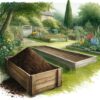pH Soil Tester Guide
Introduction
Delve into the world of gardening with a trusty 4-in-1 garden soil meter for moisture testing, pH reading and more, with a soil meter by your side. As an essential tool for any gardener, it measures the vital stats of your soil—pH, moisture, light, and temperature. This guide is your one-stop shop for expert tips on using your soil meter, understanding what your readings mean, and learning how to create the perfect environment for your plants.
Understanding Your 4-in-1 Garden Soil Meter
A 4-in-1 soil meter is a gardener’s best friend, providing valuable insights into the wellbeing of your garden:
- pH Level is a measure of acidity or alkalinity in your soil, with a range that affects various plants differently. For instance, blueberries thrive in acidic soil (pH 4.5 – 5.5), while vegetables like broccoli prefer a more neutral pH around 6.5 – 7.5.
- Moisture Content is all about achieving the ‘just right’ feeling—not too wet and not too dry. Your meter can help prevent common issues like overwatering or drought stress.
- Light Levels are categorized as full sun, partial shade, and shade. Full sun plants need over 6 hours of direct sunlight, partial shade plants prefer about 3-6 hours, and shade plants are happy with less than 3 hours or dappled sunlight.
- Soil Temperature affects seed germination and root development. For example, spinach seeds need cooler soil around 50°F to germinate, while tomatoes prefer warmer soil temperatures, around 70°F.
How to Use Your Soil Meter Effectively
Testing your garden’s soil should be part of your regular plant care routine. By checking conditions frequently, you can spot changes and adjust your gardening practices accordingly. Always ensure your meter is calibrated for accurate readings and clean the probes after each use to keep it in top condition.
Interpreting the Meter Soil Metrics
Each reading on your soil meter gives you a clue about what your plants need:
- pH Levels help you understand which plants will naturally do well in your soil or how you can amend the soil for others. Rhododendrons, for example, need acidic soil to absorb nutrients effectively.
- Moisture Levels guide you to water correctly, as different plants have varying needs. Succulents require less water, indicated by lower moisture levels, while ferns may need higher moisture levels to thrive.
- Light Intensity determines where to place plants for optimal growth. Ferns can flourish in shade, whereas sunflowers need full sun to reach their full potential.
- Temperature Readings are crucial for planting seeds at the right time. Cool-season lettuce seeds sprout best in cool soil, whereas warm-season cucumber seeds wait for the soil to warm up.
Conclusion – Using Your Meter for a Healthy Garden
With the insights from your 4-in-1 garden soil meter, you’re well on your way to creating a lush, productive garden. By regularly monitoring the pH, moisture, light, and temperature of your soil, you’ll be well-equipped to provide the best care for a wide variety of plants. Happy gardening!
Transform your garden into a vibrant oasis with the help of a 4-in-1 garden soil meter. Get yours today and start cultivating a garden that’s as robust as it is beautiful! Shop our garden moisture and pH meter.












You must be logged in to post a comment.